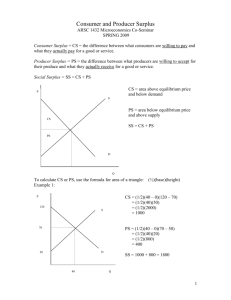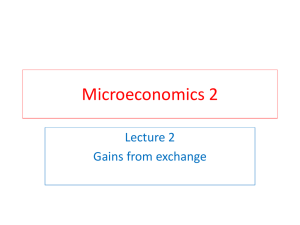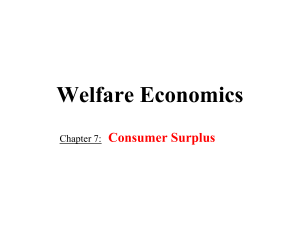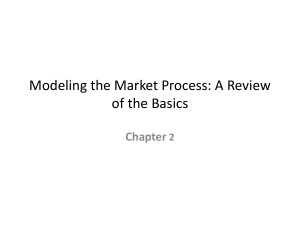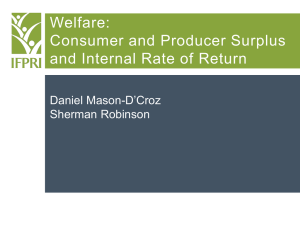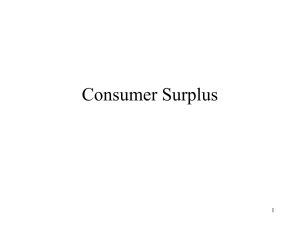Chapter 7
advertisement
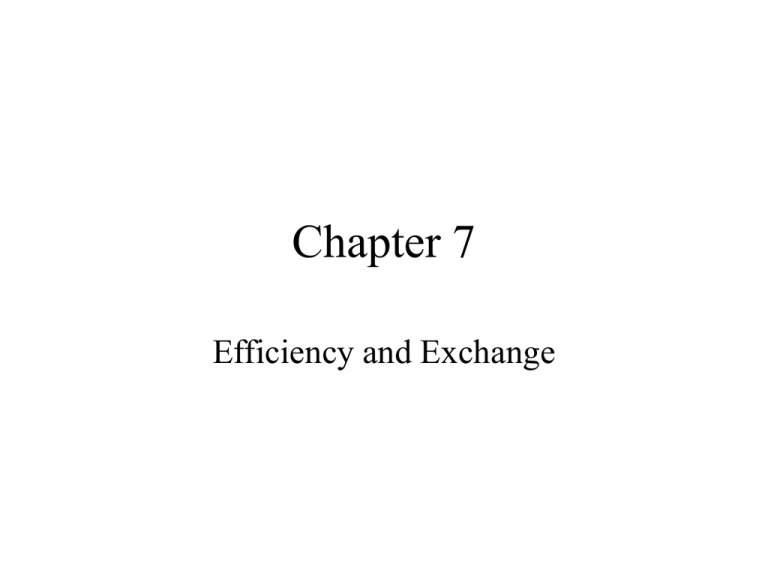
Chapter 7 Efficiency and Exchange The Domain of Markets • Markets are usually a good way to organize economic activity • Markets don’t always provide socially efficient outcomes • Government intervention can in some cases improve market efficiency Market Equilibrium and Efficiency • Pareto efficient (or just efficient) – Is a situation where there is no change possible that will help some people without harming others – Exists when an economy has reached a point where reallocating resources must harm one in order to help another – Occurs at equilibrium of perfectly competitive markets Economic Surplus • Total economic surplus – The sum of all the individual economic surpluses gained by buyers and sellers participating in the market – Consumer Surplus – Producer Surplus Surplus • Consumer Surplus – Economic surplus gained by the buyers of a product – Measured by the difference between their reservation price and and the price they pay • Producer Surplus – Economic surplus gained by the sellers of a product – Measured by the difference between the price they receive and their reservation price Fig. 7.4 A Market with “Digital” Supply and Demand Curves Fig. 7.5 Consumer and Producer Surplus Fig. 7.6 Supply and Demand in the Market for Milk Fig. 7.7 Total Economic Surplus in the Market for Milk Figure 7.4 Economic Surplus in an Unregulated Market for Home Heating Oil Economic Surplus and Efficiency • Equilibrium price and quantity maximize the total economic surplus – Total economic surplus would be lower at any other price and quantity combination – I.E., waste occurs at any other price and quantity combination Figure 7.5 The Waste Caused by Price Controls Other Goals • An equitable (fair) income distribution is a desirable goal for many • Efficiency should be a very important goal – Efficiency enables us to achieve all other goals to the fullest possible extent – Efficiency minimizes waste • However, if the choice is between an efficient but unfair outcome and an inefficient but fair outcome, what should we do? Taxes on Goods • Reasons: – Raise revenue for government activity – Modify market outcomes • Kinds – Specific or excise, in dollars per unit (gasoline) – Ad valorem, percent of price (sales tax) – Lump sum, (license fee) Three Questions • How does the imposition of the tax affect equilibrium price and quantity? • Who pays the tax? Buyers or sellers? • What is the effect of the tax on the economic surplus? Effect of an Excise Tax • Can be viewed as an addition to cost or a reduction in average revenue. Same result. • Consider the imposition of a tax of $1 per pound on potatoes. This will increase marginal cost by $1 and raise the supply curve by $1. The supply curve shifts to the left. Figure 7.11 The Effect of a Tax on the Equilibrium Quantity and Price of Potatoes Effect in the Short Run • The shift in supply causes the equilibrium price to increase from $3 to $3.5 and output to decline from three million pounds to 2.5 million pounds. • Note that the equilibrium price did not increase by the amount of the tax. This is a key observation. Taxes and Efficiency • What happens to the price of a good when the government imposes a tax on it? – Most people believe that the price of the item will rise by the amount of the tax. • However, this will not happen in the short run unless demand curve is vertical or the supply curve is horizontal. In the long run, the price will increase by the amount of the tax in a perfectly competitive industry. Figure 7.12 The Effect of a Tax on Sellers of a Good with Infinite Price Elasticity of Supply Who Bears the Burden of the Tax? • It depends on the slopes of the demand and supply curves. In our example, consumers paid 50 cents more and producers received 50 cents less. • Ceteris paribus, the steeper the demand curve, the greater will be the burden on the consumer. Likewise in the case of the supplier. Taxes and Economic Surplus • Deadweight loss – The reduction in economic surplus that results from a policy – A tax distorts the signal that free prices send Figure 7.13 The Market for Potatoes without Taxes Figure 7.14 The Effect of a $1/pound Tax on Potatoes Figure 7.15 The Deadweight Loss Caused by a Tax Taxes, Responsiveness, and Efficiency • Deadweight loss is minimized if taxes are imposed on goods and services that are not very responsive to price. • Example on the supply side: land • Example on the demand side: salt ( and cigarettes, gasoline) Taxes, External Costs, and Efficiency • Taxing reduces the equilibrium quantity • Therefore, taxing activities that people tend to pursue to excess can actually increase total economic surplus (e.g., activities that cause pollution)

